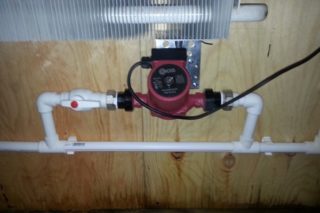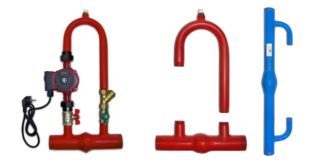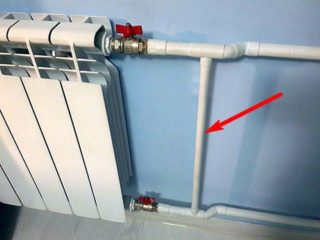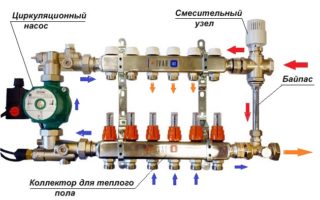Bypass in the heating system is an integral part of the installation of the heating system, which externally is a jumper or a piece of pipe mounted on the heating main parallel to the main line. It can be used to solve various problems, so it is always present in any scheme and is one of the most important elements. Experts and ordinary owners of residential premises should know about the methods of using the bypass in order to prevent possible malfunctions in time and seek help.
What is a bypass for a heating system?
A bypass is a small pipe section that is mounted so that the path for the heat carrier passes through the device itself and bypasses the unit. The term itself comes from the English word bypass, which translates as “bypass” or “bypass”. The type and structure of the element depends on the problem being solved, it can take the form of a bypass type pipeline or a section representing a straight line, which is needed to connect the return and supply lines. The part can be installed:
- on radiators in single pipe systems of closed or open type;
- next to the circulation pump, operating in a gravity flow network;
- as a jumper between the return and feed, which forms a small circulation circuit;
- in mixing units.
A standard bypass for heating can be controlled and uncontrolled, in the second case it is constantly kept open so that the fluid freely passes through the path. Often in private and apartment buildings, a control device is placed on such jumpers, it can be a valve or a special device that can change the cross section of the passage.
Variety of products
All bypasses used in the heating system are divided into three varieties, taking into account the option of stop valves and the purpose of the device itself. In general, they work on the same principle, but each species has its own characteristics.
Auto
The automatic type option is able to function autonomously, it does not need to be adjusted additionally. It does not look like a bypass standard pipe, but is a rubber valve used in conjunction with a circulation pump. After switching on, the valve pressure paves the way for the warm carrier, in the off mode it automatically closes.
Automatic bypass is installed only in hot water and heating systems with clean media without impurities, since any dirt, rust or plaque provokes deformation of the device.
Manual
This option works according to the mechanical principle by manually opening and closing the tap, which should be in the central part of the jumper. Bypass of this type, used in structures for space heating, is usually supplemented by a three-way or ball valve, both types differ only in structure and function exactly the same.
Unregulated
The unregulated bypass on the radiator is a simple pipe without accessories that is open all the time. The fluid inside it is able to move arbitrarily, which makes it impossible to change the speed and intensity of the carrier. The installation of such devices is only relevant for connecting units that are able to qualitatively heat the room.
Where is the bypass used?
The bypass must keep the entire system operational even if one of its components breaks down or the power is cut off. All units that are connected using the device can be easily disconnected from the base, for this you only need to close two taps, after the heat carrier goes along the bypass path.
The correct bypass simple pipeline is installed at arm's length from the floor or higher. These are the minimum requirements for its installation in accordance with the standards.
On the radiator harness
The jumper is used only for radiator devices operating in single-pipe heating structures, it is not needed for two-pipe circuits, since in this case all units will be connected in parallel to each. Since single-pipe wiring requires a serial connection, the coolant will cool down as it approaches each device, the farthest of which will receive a minimum of heat. Bypass solves this problem, helping to make the flow movement independent and help the coolant pass directly into the radiator.
On the circulation pump
The circulation pump is connected using the device only in structures with natural circulation, in this case, a bypass is needed only to enhance the efficiency of operation. This is a good option for systems in which an overclock type collector is installed, as well as pipes in compliance with the desired slope and diameter. Forced circulation systems do not require a bypass.
For underfloor heating
In warm floors of any type, a mixing unit with a bypass bypass is constantly installed. The jumper itself is needed so that the work of the warm floor goes smoothly, this is an important element without which the system will not be able to function. In heated coatings, a certain temperature should be maintained all the time, the bypass is responsible for its adjustment and bringing to the required value.
Installation Instructions
In order not to make mistakes during installation and to carry out the correct calculation, you need to take into account the nuances of connecting the bypass. You can mount the tube when creating a new system or repairing an installed structure. In the second case, you will need to install stop valves, pipes and tees made of polypropylene or other materials. If you are talking about connecting a radiator, you need to remember:
- the circumferential section inside should be less than one step in the diameter of the pipe of the main type;
- Bypass installation is carried out at a minimum distance from the radiator;
- In a block of flats, cranes are not permitted on the bypass.
Compliance with the standard rules for installation and operation of the bypass will help ensure the complete operation of the system and avoid possible emergency situations.






